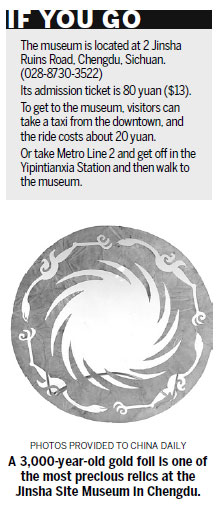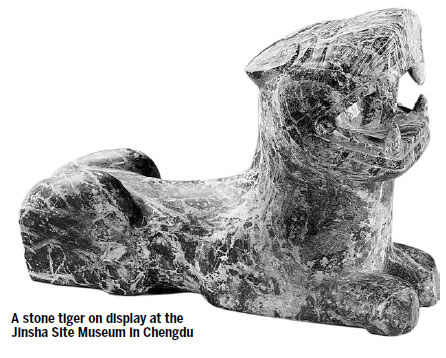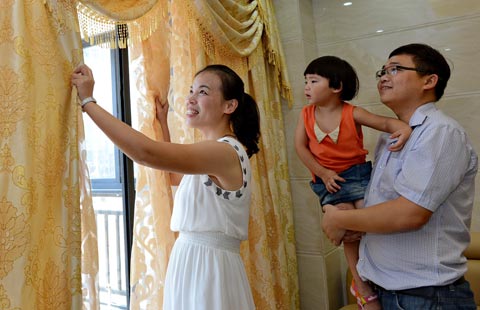Gold relics set Jinsha excavation apart
Updated: 2014-08-05 07:20
By Huang Zhiling in Chengdu(China Daily)
|
|||||||||||
Visitors to Chengdu, capital of Southwest China's Sichuan province, are curious about a circular golden emblem that can be seen in many parts of the city.
It can be seen on engine hoods of taxis, the overpass en route to the airport and on local television channels.
The emblem, featuring four flying birds surrounding the sun, is a replica of a gold foil which was unearthed in the Jinsha Ruins in western Chengdu in early 2001 and is on display in the Jinsha Site Museum.
On Feb 8, 2001, workers at a real estate construction site in Jinsha village, found ivory and jade in the piles of debris.
Archaeologists have since excavated some 6,000 precious relics including gold, jade, bronze and stone wares as well as a ton of elephant tusks and tens of thousands of pottery and ceramic pieces.
The excavation of the Jinsha Ruins was hailed as one of the top 10 archaeological finds that year by the Archaeological Society of China and China Cultural Relics News.
The ruins, covering an area of 4 square kilometers, include a sacrificial site, a palace, houses of the nobility and commoners, and a graveyard. "The ruins might have been a capital of the ancient state of Shu," says Wang Yi, curator of the Chengdu Museum who was in charge of the excavation.
Shu was the name for Sichuan in ancient times and Jinsha literally means "gold sand" in Chinese.
The most eye-catching relics on display in the museum are the sunbird gold foil and a "smiling" gold mask.
The gold foil is believed to be about 3,000 years old. Measuring 12.5 centimeters in diameter and weighing 20 grams, it is a mere 0.02 cm in thick. It has four birds cut out of it and 12 rays of the sun radiating from its center. It is seen as an illustration of an ancient Chinese myth recorded in the classic Legends of Mountains and Seas written some 2,500 years ago.
According to the book, the ancients believed the sun was carried up to the sky in the morning and pulled down at dusk by four birds.
The State Administration of Cultural Heritage adopted the sunbird gold foil as the country's symbol of cultural heritage in 2005.
Visitors to the museum are impressed by the gold mask as well.
About 3.7 cm tall and 4.9 cm wide, the mask is thin and has brows like a crescent moon and eyes like almonds. Its half-opened mouth has a smiling effect.
"The mask is unique, for gold masks like it have never been unearthed in other parts of China," says Zhu Zhangyi, an archaeologist at the museum.
The smiling gold mask was not donned by a living person. Instead, it was affixed to a bronze human head or a wooden human head, he says.
Some scholars believe the bronze head represents the soul of a dead ancestor, while others hold that it is the image of a necromancer and the bronze head is probably that of a high-ranking shaman. Experts agree that the bronze heads were worshipped by ancient Sichuan people who believed that they were channels to higher beings and would afford protection.
huangzhiling@chinadaily.com.cn


(China Daily 08/05/2014 page20)
Today's Top News
NATO to offer tailored support to Ukraine
Babies bob about in water at US's first baby spa
News website staff face extortion probe
China's meeting on 13th five-yr plan
Number of visitors to China drops
Export of mooncakes on the rise
Putin outlines ceasefire plan for Ukraine crisis
China paves way for sports investors
Hot Topics
Lunar probe , China growth forecasts, Emission rules get tougher, China seen through 'colored lens', International board,
Editor's Picks

|

|

|

|

|

|





